Wish you could grow more food in your yard? One often overlooked place to grow food is the lawn, which can be stealthily replanted with delicious, low-growing ground cover herbs. Whether you replace a little or a lot, consider exchanging some of your grass for these fragrant, beautiful low-growing herbs as ground covers.
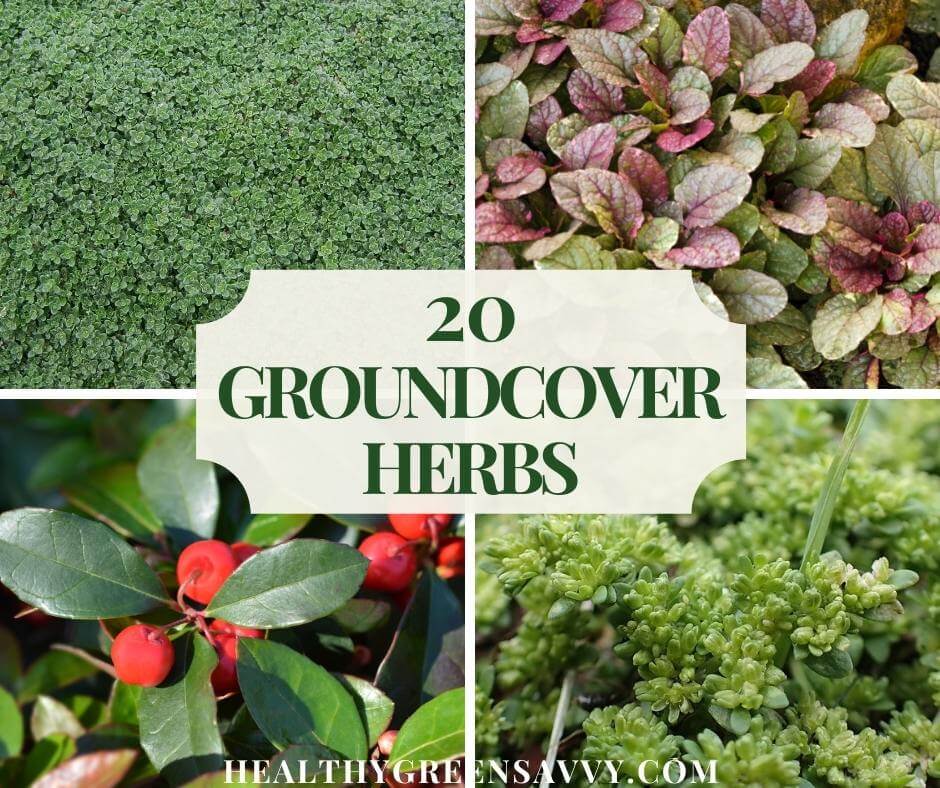
- WHERE TO GROW GROUND COVER HERBS
- HOW TO CHOOSE GROUND COVER HERBS
- GROUND COVER HERBS LIST
- LOW GROWING GROUND COVER HERBS
- CLOVER AND MICROCLOVER (TRIFOLIUM)
- THYME (THYMUS)
- RUPTUREWORT (HERNIARIA GLABRA)
- CREEPING ROSEMARY (ROSMARINUS OFFICINALIS "PROSTRATUS")
- CREEPING MINT (MENTHA REQUIENII)
- ROMAN CHAMOMILE (CHAMAEMELUM NOBILE)
- CREEPING CHARLIE (GLECHOMA HEDERACEA)
- OREGANO (ORIGANUM VULGARE 'HUMILE')
- WOOLLY YARROW (ACHILLEA TOMENTOSA)
- BUGLEWEED (AJUGA REPTANS)
- WINTERGREEN (GAULTHERIA PROCUMBENS)
- VINCA (VINCA MAJOR)
- WILD GINGER (ASARUM CANADENSE)
- EUROPEAN SPEEDWELL (VERONICA BECCABUNGA)
- TALLER GROUND COVER HERBS
- LOW GROWING GROUND COVER HERBS
WHERE TO GROW GROUND COVER HERBS
Each year, as more people recognize the environmental impacts of the traditional lawn and discover the joys of growing their own food, more lawns are being converted to flowering bee lawns and other grass alternatives.
One savvy way to get more out of your yard is to replace some of that lawn with things your family can eat or use medicinally. Replacing some or all of a grass lawn with edible ground cover herbs means you’ll have delicious ingredients for cooking, enjoying in herbal teas, and stocking your home remedy toolkit.
Another place to consider planting more herbal groundcovers is in perennial beds where you currently have mulch. Using ground cover herbs as a living mulch encourages microbial activity in the soil and means you don’t need to truck in mulching materials, reducing the environmental impact of your garden.
Here’s more on creating the most eco-friendly yard with ecological landscaping.
If you’re growing a medicinal herb garden, these herbal ground covers can also work as a living mulch between your taller medicinal plants. Or if you’re planning a front yard vegetable garden, you can incorporate these herbal groundcovers into your design for a more polished landscape.
HOW TO CHOOSE GROUND COVER HERBS
Before buying and planting ground cover herbs, you have several things to consider:
- Light — Is the area sunny or shady?
- Foot traffic — Do you want to be able to walk in this area?
- Watering needs — If the herbs you choose require frequent watering, you’ll want to make sure they’re somewhere you’ll be able to easily keep them well watered
- Height — Do you want something that stays very low to the ground, or is 6-10 inches OK?
- Taste preferences — Which herbs would you actually harvest for food or medicinal purposes?
- Area to cover — Will you plant a large or a small space with ground cover herbs or just tuck them in among taller perennials?
Some ground cover herbs will do fine with minimal watering and may be placed further away from the areas you water regularly, while others will want the soil to be kept moist and should be planted where it’s convenient for you to do.
If you have shadier parts of your yard, you’ll want to choose herbs for shade and plant herbs that require more sun where they can get the light they need.
Ready to cover some ground with herbal goodness? Read on for 20 ground cover herbs to consider adding to your garden.
WHERE TO GET GROUND COVER HERBS
Many of these plants are perennial herbs, which means you may be able to get them as divisions from other gardeners. Just be sure the garden you’re getting it from isn’t one of the unlucky ones colonized by the dreaded jumping worm, an invasive you should learn to recognize. Here’s what to know about identifying and dealing with Asian jumping worms.
You can also grow many of these plants from seeds, or root them from cuttings. Here’s what to know about propagating plants from cuttings.
High Mowing Seeds, Botanical Interests, Seeds Now, Eden Brothers, and True Leaf Market carry seeds for many of the herbs listed below. You’ll also find a wide selection of seeds from small growers on Etsy.
GROUND COVER HERBS LIST
**ALWAYS CONSULT WITH A PHYSICIAN BEFORE TAKING HERBS. MANY HAVE SIDE EFFECTS AND DRUG INTERACTIONS YOU NEED TO RESEARCH BEFORE CONSUMING.**
If you’d like to learn more about using medicinal plants safely and effectively, check out some of these herbal medicine books for your herbal reference library. You might also consider taking one of the info-packed herbal courses offered by the Herbal Academy.
LOW GROWING GROUND COVER HERBS
For those areas where you want low growing herbs as ground covers, to replace a lawn, for instance, you have a number of options. Note that some herbs withstand foot traffic better than others. If you plan to walk on your ground cover, check the note about foot traffic included in each herb’s description.
CLOVER AND MICROCLOVER (TRIFOLIUM)

One especially popular ground cover herb is clover, which most people plant as a hardy replacement for grass but don’t realize is both edible and medicinal.
Young clover leaves can be picked and used in salads or added to soups and stews.
Clover flowers are often used for tea, either fresh or dried. They can also be added to baked goods like muffins, or turned into flour.
Clover-infused vinegar can be used in salad dressings or medicinally. Clover is a traditional herbal remedy for coughs and colds, hormonal issues, and skin problems. Here’s more on edible clover and its uses.
Clover has the added benefit of fixing nitrogen, making it a self-fertilizing planting once established. It’s also far more drought-tolerant than grass. Bees love all the blooms, too!
If you want a lower-growing clover, you can now get something called micro clover online. Micro clover will withstand foot traffic better, but it has fewer blooms and doesn’t stay green as long as traditional white clover. Here are some options for both Dutch white clover and microclover.
Light: Full sun to part shade
Height: 3 to 8 inches
Soil: Can handle clay, prefers neutral pH
Foot Traffic: Micro clover will hold up better than standard white clover
Growing zones: 3-10, depending on variety
THYME (THYMUS)
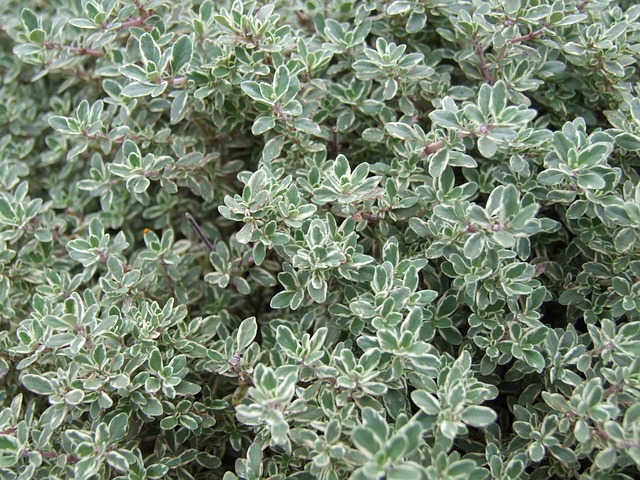
Thyme makes a beautiful and fragrant herbal ground cover and is a versatile culinary and medicinal herb. In addition to being tasty in soups or cooked with fish and poultry, thyme is an excellent anti-microbial and is a top choice herb for coughs. Here’s an easy thyme tea recipe for the next time you need relief from cold symptoms.
Note that the creeping versions of thyme are typically used as ground cover herbs, but they aren’t necessarily the easiest to harvest. I grow loads of lemon thyme all over my yard for its lovely smell, pollinator-attracting flowers, and cold-hardiness. But I use it only occasionally in cooking, instead harvesting and drying plenty of common upright thyme for use in winter.
Learn more about how to dry thyme.
Wooly thyme is a top choice for its silvery low-growing foliage and ability to withstand foot traffic, and several other types of thyme grow in low mats, including lemon thyme and variegated thyme. Just check the hardiness zones to ensure the variety you have is suited to your climate.
It’s one of many drought-tolerant ground covers to consider to cut back on the water your garden needs. It can also be used as a companion plant for perennial food crops. Try it as a rhubarb companion plant.
Light: full sun
Height: 2 to 3 inches
Soil: prefers well-drained soil with pH between 6 and 8
Foot traffic: Low-growing woolly thyme is considered the best choice for places you plan to walk
Growing zones: 4-8
RUPTUREWORT (HERNIARIA GLABRA)

Rupturewort is so-named for its usefulness in treating ruptures of the skin. Its Latin name comes from its historical use for treating hernias. A potent diuretic, rupturewort has been used to treat bladder and kidney conditions.
This lesser-known ground cover herb is an excellent choice where you want to fill in with a dense mat of foliage that stays green year round. Also known as Green Carpet for its excellent spreading abilities and evergreen leaves, rupturewort is drought-tolerant and can do well in poor soil. You can purchase seeds here.
Light: full sun to part shade
Height: 3 inches
Soil: acidic to neutral
Foot traffic: Yes
Growing zones: 4-8
CREEPING ROSEMARY (ROSMARINUS OFFICINALIS “PROSTRATUS”)

Creeping or prostrate rosemary is a lesser-known type of rosemary, with a greener color and flavor that, as the name suggests, creeps along the ground rather than growing upright. I absolutely love the flavor of creeping rosemary, and grow it every year though it’s not perennial in my area.
Note that most descriptions of creeping rosemary list its height as up 12 inches, which means it’s not a plant that will work well to cover large areas you want to walk on. Use creeping rosemary as an accent or at the side of pathways, and plan on using clover or wooly thyme for spots where you want to walk.
Light: Full sun
Height: 2 to 12 inches
Soil: Well-draining, neutral pH
Foot traffic: No
Growing zones: 8-10
–> Need some gardening gear? Check out our new line of t-shirts!
CREEPING MINT (MENTHA REQUIENII)

Also known as Corsican mint, this low-growing mint is great for filling in larger areas, though it’s not quite tough enough to withstand foot traffic. Its small minty leaves smell lovely and can be used for tea or in recipes calling for mint.
Remember that all mints can be pretty aggressive, so plant creeping mint where you want it to take over. Best if it has some natural borders to control it, like a driveway or cement sidewalk.
If you don’t mind taller plants, other types of mint will also take over any area you let them and are far hardier than Corsican mint, growing reliably in very cold climates.
I’m a big fan of chocolate mint, which stays attractive far longer than other types of mint and sports pretty flowers the bees love. It fills in areas beautifully, though like other mints it has a tendency to spread where you don’t want it.
Light: Tolerates full or part sun
Height: 1 inch
Soil: Prefers moist, acidic to neutral pH soils
Foot Traffic: No
Growing zones: 7-9
ROMAN CHAMOMILE (CHAMAEMELUM NOBILE)

Chamomile is a lovely, medicinally-useful plant that’s a favorite herb for promoting sleep and relaxation. You’ve likely had German chamomile as tea; this popular herbal ingredient is an annual, while its cousin Roman chamomile is a perennial that can be used as a ground cover herb. Roman chamomile also has more of a creeping habit, making it better suited for ground covers.
Unlike more drought-tolerant ground covers, chamomile needs consistent watering, so plant it somewhere you won’t forget to water it.
Light: sun to part shade
Height: 1 to 6 inches
Soil: Prefers moist, acidic to neutral soils
Foot Traffic: No
Growing zones: 3-10
CREEPING CHARLIE (GLECHOMA HEDERACEA)

Surprised to see this bane of many a homeowner’s existence on a list of ground cover herbs? The edible and medicinal uses of creeping Charlie make it worth considering if you have ground to cover.
Once a prized medicinal plant, creeping Charlie (also known as ground ivy) is considered useful as an anti-inflammatory, pain reliever and diuretic, among many other uses. Here’s more on creeping Charlie uses.
Yes, this member of the mint family can be very invasive, but that’s one of the things that makes it a valuable herbal ground cover. I wouldn’t necessarily recommend planting it if you don’t have it already, but if you do, consider embracing rather than fighting it, as you’re unlikely to win.
If we hadn’t labeled it a weed, I suspect a lot more yards would be covered with creeping Charlie and everyone could waste a lot less energy mowing lawns. People who don’t know creeping Charlie is considered a weed always admire its pretty purple flowers and attractive foliage. Plus it stays green late into the season and greens up earlier than just about anything else, great for those of us itching to forage in our yards in spring!
Pollinators love those little flowers as well. If you want to help protect your local pollinators, here’s why to consider participating in the No Mow May movement.
Light: Part shade to sun
Height: 3-8 inches
Soil: Not fussy, grows just about everywhere!
Foot Traffic: Yes
Growing zones: 3-10
OREGANO (ORIGANUM VULGARE ‘HUMILE’)

Spicy oregano is both a delicious culinary herb and a useful medicinal. For a low-growing ground cover, you’ll want to choose the creeping variety of oregano (Origanum vulgare ‘Humile’), which unfortunately for northern gardeners, is only hardy from zones 6-11. In colder climates, you’ll need to choose hardier, but also taller-growing oregano. On the plus side, taller oreganos generally are easier to harvest for culinary purposes.
You can encourage oregano to spread outward by pinching off top growth throughout the season, or you can mow it.
Light: Full sun to part shade
Height: 3 to 24 inches, depending on variety
Soil: neutral, well-drained
Foot Traffic: some varieties
Growing zones: 4-11, depending on variety
WOOLLY YARROW (ACHILLEA TOMENTOSA)
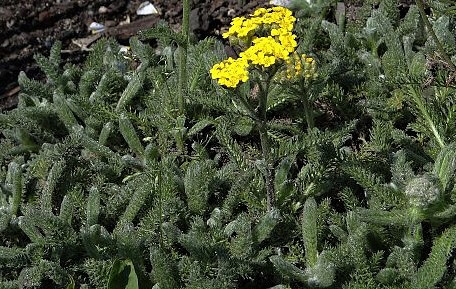
Woolly yarrow is a low-growing type of yarrow, that like other types, is drought-tolerant and tough. Woolly yarrow grows into a dense mat and sports yellow flowers pollinators love in midsummer.
Yarrow has many medicinal uses, including wound healing, fever reducing, and pain relief.
Here’s more on yarrow uses and benefits.
Light: Full sun
Height: 6 to 8 inches
Soil: Prefers drier soils
Foot traffic: Can handle light foot traffic
Growing zones: 3-7
BUGLEWEED (AJUGA REPTANS)
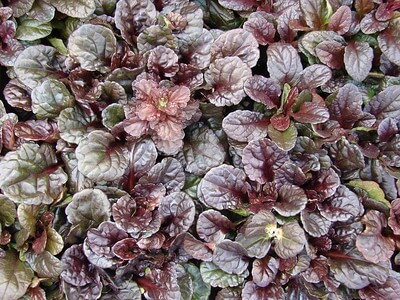
Known commonly as bugle or bugleweed (and often confused with another plant called bugleweed, Lycopus virginicus), ajuga belongs to the mint family and shares mint’s predilection for spreading.
One of the plants that can tolerate juglones from black walnut trees, ajuga has attractive dark green or purplish leaves and can handle part shade conditions. Consider carefully before planting, as ajuga has a reputation for taking over. Best to check your state’s invasive plant list to see if it’s considered invasive in your area.
Herbalist Maud Grieve reports that traditional uses for ajuga include staunching bleeding and slowing heart rate. In Making Plant Medicine, Rico Cech recommends using a poultice or infusion of leaves, flowers, and stems externally for pain relief and healing of insect stings and cuts. He says a tea may soothe persistent coughs.
Light: Sun to part shade
Height: 6 to 9 inches, though some varieties stay just a few inches tall
Soil: Prefers moist, slightly acidic soils
Foot Traffic: No
Growing zones: 3-9
WINTERGREEN (GAULTHERIA PROCUMBENS)
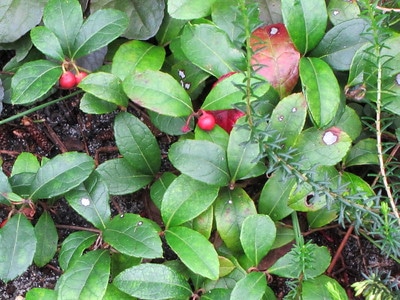
Wintergreen’s minty leaves and edible berries are a fun addition to the edible landscape. A slow-growing perennial, with time wintergreen will spread by rhizomes.
The bright red berries and bronze foliage add winter interest to areas when other plants have died. Native to eastern North America, wintergreen requires little care beyond consistent watering.
Wintergreen has been used medicinally for pain relief and the berries are reported to be edible. However, potential toxicity has caused wintergreen to lose favor. In The Green Pharmacy, ethnobotanist James Duke notes that wintergreen contains methyl salicylate, a natural pain-relieving compound found in several plants. He recommends the oil for external use to relieve pain for conditions like sciatica and gout, and tea made from the leaves for sore throat. He cautions to keep all wintergreen products away from children, as small amounts can be deadly when ingested,
Note that some people get wintergreen (gaultheria procumbens) mixed up with winterberry (ilex verticillata), a shrub in the holly family that is quite toxic.
Light: Part shade
Height: 6″
Soil: Prefers moist, slightly acidic soils
Foot Traffic: Light
Growing zones: 3-8
VINCA (VINCA MAJOR)

Though in large quantities, vinca, known commonly as periwinkle, is considered toxic, it has a long history of medicinal use. According to Maud Grieve, it was used to stop bleeding and alleviate pain, among many other uses. The alkaloids in vinca have been used by the pharmaceutical industry for treating diabetes, high blood pressure, and cancer. Not often used for home medicine these days, do your research and proceed with caution before using.
This readily-available ground cover can be found at most garden centers. It’s a popular landscaping plant because its leaves stay green in winter, it has cheerful little blue flowers, and tolerates shade. It’s considered useful for slopes where you’re trying to control erosion.
Vinca spreads well, though its ability to do this sometimes lands it on lists of invasive plants. One writer at Garden Rant takes issue with its inclusion there. Worth a read if you’re considering using vinca as a ground cover herb and are concerned about its possible invasiveness.
Light: Full to part shade
Height: 3-6″
Soil: Prefers moist, well-drained soil
Foot Traffic: No
Growing zones: 4-9
WILD GINGER (ASARUM CANADENSE)
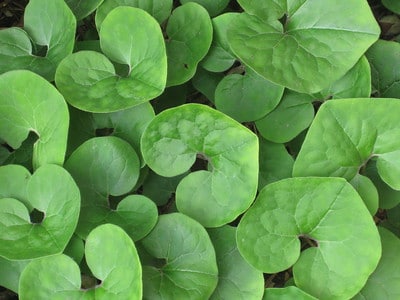
A native woodland plant, wild ginger makes a great ground cover herb for shadier spots in the yard, though it can get a bit invasive, popping up in new areas each season.
Wild ginger has fuzzy, heart-shaped leaves that come out early in the season. Its flowers bloom just above the soil, and aren’t easy to spot amidst the foliage.
Native Americans and European settlers used wild ginger’s rhizome as a spice as well as medicinally, but Hank Shaw of Hunt Gather Cook counsels caution when using wild ginger.
Light: Part shade
Height: 6″
Soil: Prefers moist, slightly acidic soils
Foot Traffic: No
Growing zones: 4-8
EUROPEAN SPEEDWELL (VERONICA BECCABUNGA)
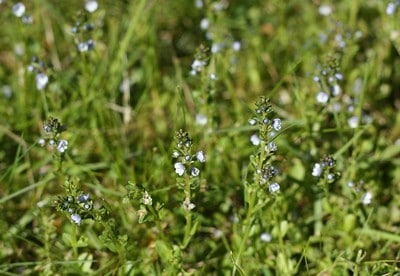
Unlike the upright, often floppy speedwells you’ve likely seen in many a landscape, European speedwell (Veronica beccabunga) grows only 4 inches high. A creeping herb with evergreen leaves, it’s another good choice where you want a mat of green.
European speedwell prefers moist soils and is often likened to watercress, though the flavor is considered inferior. Considered a cleansing plant, European speedwell contains anti-inflammatory compounds, likely why it was used to address swelling and gout.
Light: Sun to part shade
Height: 4″
Soil: Prefers moist soils
Foot Traffic: No
Growing zones: 5-9
CREEPING VALERIAN (VALERIANA SUPINA)
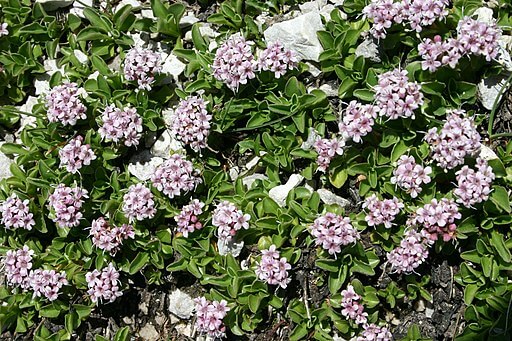
This aromatic plant forms a mat of green with pink flowers pollinators will enjoy. Valerian root is a longstanding herb used for addressing insomnia and anxiety. Its antispasmodic properties make it useful for treating coughs. However, only certain types of valerian are used by herbalists, so there isn’t information on whether one can use creeping valerian this way.
Best to enjoy it as a lovely herbal ground cover rather than harvesting the roots. If you find something on using this variety of valerian, do let me know!
Light: Sun to part shade
Height: 4 to 6 inches
Soil: tolerates a range of soils
Foot Traffic: Light
Growing zones: 4-9
TALLER GROUND COVER HERBS
SWEET WOODRUFF (GALLIUM ODORATUM)
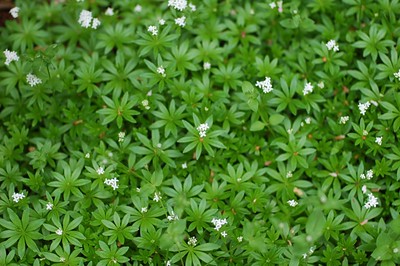
Sweet woodruff (Gallium odoratum) makes an attractive and low-maintenance ground cover herb. In the gallium family along with cleavers, sweet woodruff also has a number of historical medicinal uses, though its coumarin content has made its use for internal purposes discouraged.
Its pleasant scent made it useful in the Middle Ages as a strewing herb and mattress stuffing (hence the common name bedstraw).
Growing to about a foot high, sweet woodruff creates a mat of pretty green foliage with attractive white flowers.
Light: Part to full shade
Height: 6 to 12 inches
Soil: Prefers moist, well-drained soil; can tolerate a wide range of pH levels
Foot Traffic: No
Growing zones: 3-8
WILD VIOLETS (VIOLA SORORIA)

Wild violet is a lovely carefree ground cover herb that naturalizes nicely in shadier parts of the yard. The flowers are edible and look pretty in salads, and the leaves may be harvested throughout the season as a medicinal herb.
One downside of violets as a ground cover for a large area is that they take a little longer to green up in spring than some other plants, so while grass lawns will be fully green early in the season, a yard planted in violets will stay brown several weeks longer. Of course, they never need mowing and you can eat them, so I think the tradeoff is worth it.
Here’s what to know about using edible wild violets, plus wild violet recipes to try in the kitchen and herbal apothecary.
Light: Part shade to sun
Height: 4 to10 inches
Soil: Moist, but well drained
Foot Traffic: No
Growing zones: 3-9
LAMB’S EARS (STACHYS BYZANTIA)

Did you know this popular perennial has medicinal properties? Used for wound healing, the fuzzy leaves are good at absorbing blood and are sometimes used as a wild bandage. The young leaves are also edible and can be brewed into tea.
A relative of wood betony, lambs ears (Stachys byzantina), has analgesic and antimicrobial properties.
Lamb’s ears will spread, creating an attractive fuzzy mat in your garden. The leaves remain close to the ground, topping out at 4 to 6 inches though the plant will occasionally send out a taller (12 to 18 inches) flower stalk.
Light: Full to part sun
Height: Leaves, 4 to 6 inches; flowers up to 18 inches
Soil: Moist, well-drained, slightly acidic
Foot Traffic: No
Growing zones: 4-9
GOUTWEED (AEGOPODIUM PODAGRARIA)

Also known as ground elder because the flowers vaguely resemble elderflowers, goutweed (Aegopodium podagraria) is not related to the elder we know and love as elderberry (Sambucus nigra or canadensis). Goutweed’s name, not surprisingly, comes from its use as a remedy for gout. Maud Grieve reports its use for sciatica and joint pain as well.
Note that one of goutweed’s many other names is snow-on-the-mountain, which is also the name of a poisonous plant in the spurge family, Euphorbia marginata. As always, make sure to do your research before consuming any new plant!
Considerably taller than many of the ground cover herbs listed above, goutweed nonetheless has a spreading habit that makes it good for covering ground. Too good, in many gardeners’ opinions. Goutweed is considered an invasive species and is a prohibited plant in many states.
I was given the variegated kind by a neighbor many years ago, and planted it in a part shade location next to the driveway about 15 years ago, and it filled in and has stayed put without causing problems. I’ve read variegated goutweed is better-behaved than the plain green sort, and our extreme climate and the shady location have probably helped keep it in check.
Consider the pros and cons carefully before planting goutweed as a ground cover herb.
Light: Sun to part shade
Height: 12 to 18 inches
Soil: Prefers moist, well-drained, neutral range soil
Foot Traffic: No
Growing zones: 3-9
BEARBERRY (ARCTOSTAPHYLOS UVA URSI)
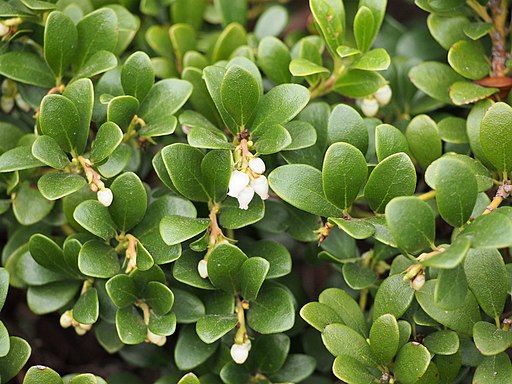
Tolerant of poor soils, cold climates, and salt, bearberry (Arctostaphylos uva ursi) is a popular landscape plant for erosion control, especially on slopes. Bearberry gets its name from bears’ predilection for the tart little red fruits, but it’s the leaves that are typically used in herbal medicine.
Bearberry leaves are diuretic and are most often used for UTIs. Anti-inflammatory and astringent, bearberry leaves have long been used by Native Americans and First Nation peoples, and the European Medicines Agency includes them in their approved herbal medicines for mild UTIs. However, risks of liver damage and drug interactions mean anyone considering taking bearberry needs to proceed with extra caution.
Light: Sun to part shade
Height: 6 to 12 inches
Soil: Prefers acidic soils
Foot Traffic: No
Growing zones: 2-6
Have you tried using herbs as groundcovers? Which are your favorites?
Pin to save this info on ground cover herbs for later!

Additional ground cover herbs photo credits (cover collage & pin): Ailime, tacojim, Nahhan, Agnieszka Kwiecień, Amanda Walker, Liz West
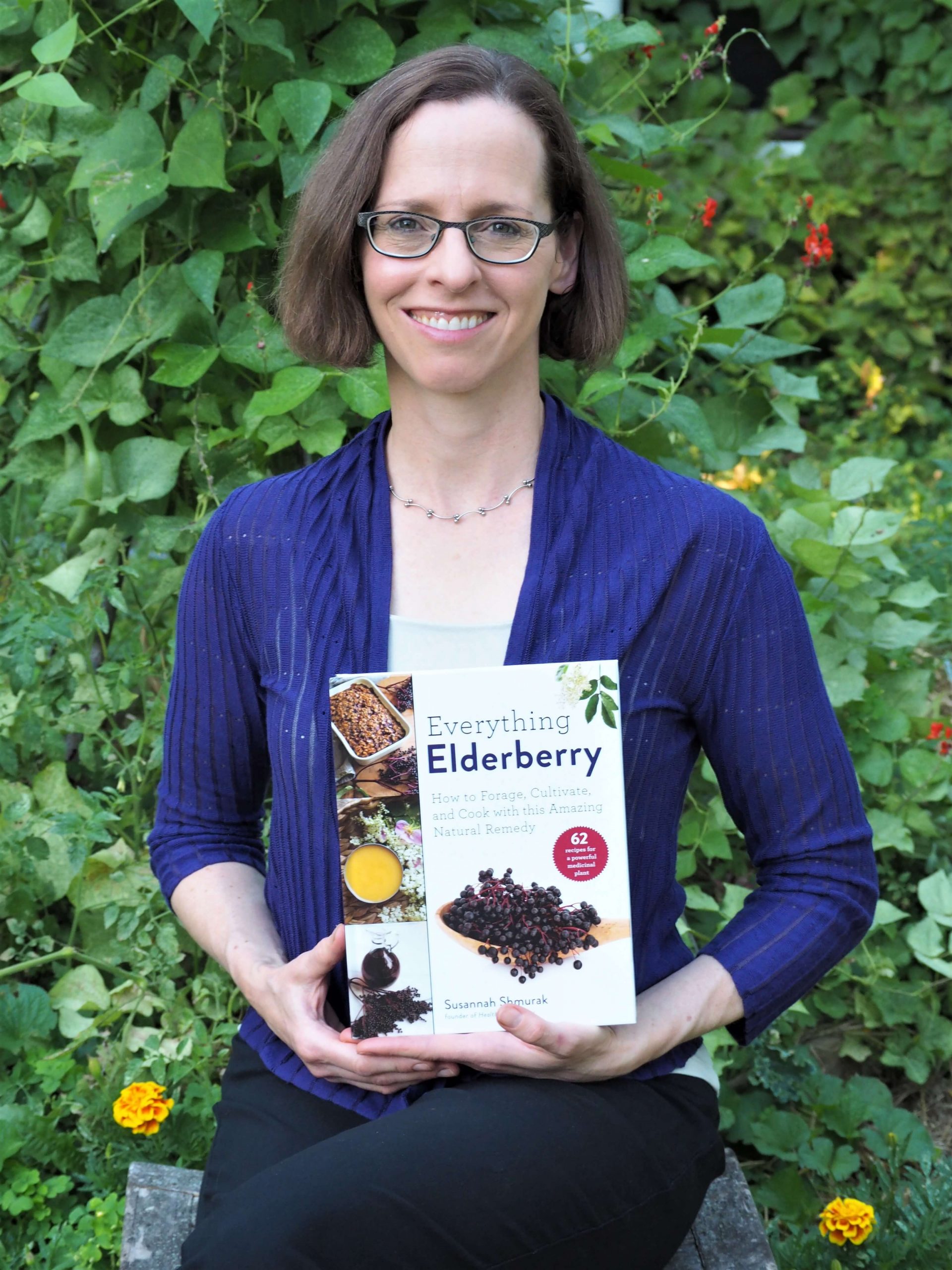
Susannah is a health and environmental writer focusing on gardening, foraging, medicinal plants, and sustainability. Her work has appeared in Mother Earth Living, Ensia, Northern Gardener, Sierra, and on numerous websites. Her first book, Everything Elderberry, released in September 2020 and was a #1 new release in holistic medicine, naturopathy, herb gardening, and other categories. Find out more and grab your copy here.








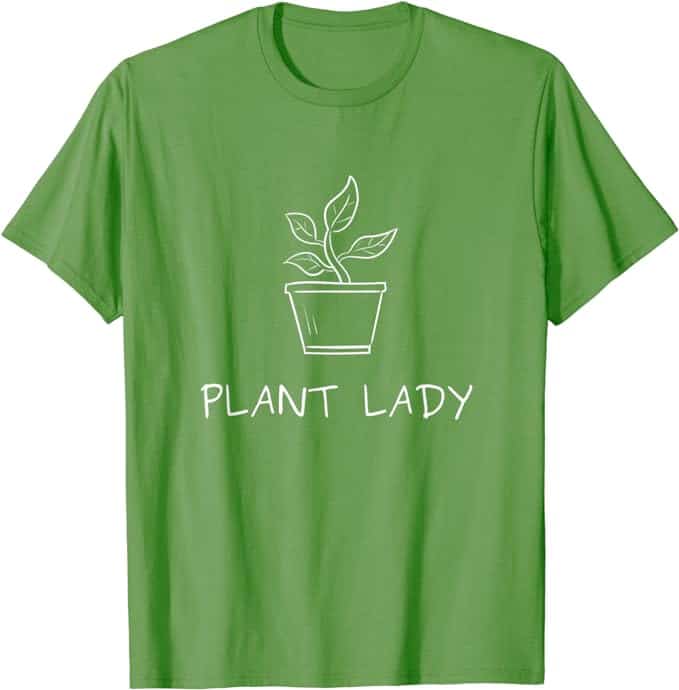
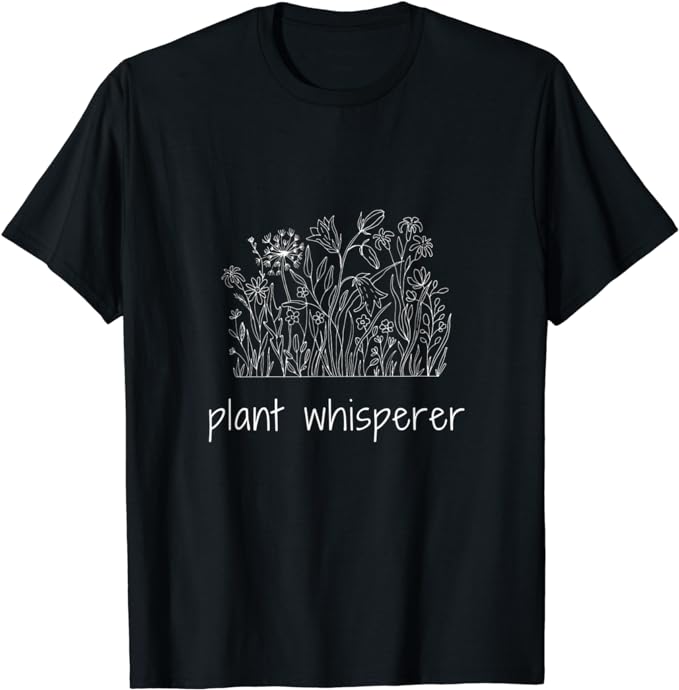
 Hi, I'm Susannah, a garden geek, energy nerd, and fan of healthy food and natural remedies. Need some simple, practical solutions for living healthier and greener? You've come to the right place! More about me and my green projects
Hi, I'm Susannah, a garden geek, energy nerd, and fan of healthy food and natural remedies. Need some simple, practical solutions for living healthier and greener? You've come to the right place! More about me and my green projects